
Things we like
- Terrific chassis and steering
- Muscular powertrain
- A fast and useable daily driver
Not so much
- Expensive
- Poor seat adjustment
- +R suspension setting too stiff for road use
Kaizen.
If you had to sum up the 2023 Honda Civic Type R in a single word, that’s it. For Japanese carmakers, kaizen means continuous improvement, and the new Type R is a masterclass in the art and science of the process.
Every tiny piece of the FL5 Type R, from the powertrain to the suspension to the steering and brakes and gearshift and driver support systems, all of which are based on hardware used in the previous generation FK8 model, has been lovingly, meticulously, polished and preened to tease out incremental improvements in performance and handling and all-round driveability.
And what does that all that mean? In simple terms, confidence.
JUMP AHEAD
2023 Honda Civic Type R pricing and availability
Australian order books open for the new Civic Type R on December 1, and a drive-away price of $72,600 has been confirmed. Get all the details at the link below, and continue reading here for our first drive impressions.
| 2023 Honda Civic Type R features for Australia | |
|---|---|
| Individual drive mode in addition to Comfort, Sport and +R | 9.0-inch central infotainment touchscreen |
| Active exhaust valve | Wireless Apple CarPlay |
| 265/30 Michelin Pilot Sport 4S tyres | Wireless phone charger |
| 10.2-inch digital driver display | Honda LogR telemetry system |
| Blind-spot information system | Satellite navigation |
| Rear cross-traffic alert | Acoustic windscreen |
| Traffic sign recognition | Smart Clear Wiper windscreen wiper/washer system |
| Intelligent speed limiter | Auto-retractable door mirrors |
| Driver attention monitor | Full suede-effect seat trim |
| Knee airbags (driver and front passenger) | Ambient door and footwell lighting |
This Type R the definition of a great driver’s car; its calm and consistent demeanour under pressure invites you to explore the very edge of the performance envelope
You can, as we did, jump into the new Type R on a damp and unfamiliar racetrack and within a couple of laps be driving the wheels off the thing, revelling in the muscular response of the 2.0-litre VTEC turbo four, the snickety-snick-snick of the gearshift, the easy playfulness of the chassis, the meaty yet precise steering, and brakes that never give up.
This Civic Type R the definition of a great driver’s car; its calm and consistent demeanour under pressure invites you to explore the very edge of the performance envelope – yours, or, if you’re good enough, that of the machinery – and it won’t rip your head off when you make a mistake.
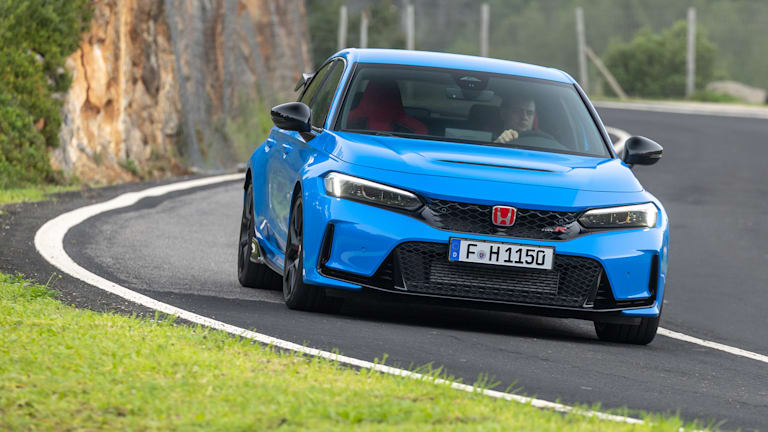
New Civic Type R styling and shape
Visually, the new Type R has none of the manga comic craziness of the FK8.
That’s partly because the fundamental design of the five-door Civic hatch is much cleaner and more sophisticated than that of the previous model, but also because Honda engineers have spent a lot of time working with their motorsport colleagues on reducing drag while increasing downforce. The rear wing, combined with the rear diffuser, the redesigned bonnet and sporty front fascia, all work together to produce 92kg of downforce at 200km/h.
There’s no mistaking the more aggressive front and rear fascias, the vents on the bonnet and behind the front wheels, and those three bazooka-calibre exhausts looming under the rear bumper. There’s Type R DNA all over the car.
The FL5 body is slightly bigger in every dimension, making this the biggest Civic Type R yet, but in terms of its mission, the important dimensional changes versus the previous model are the 35mm increase in the wheelbase, the 26mm increase in the front track, the 30mm increase in the rear track, and the lowering of the driver and front passenger H-point by 8mm.
The longer wheelbase, wider track, and lower centre of gravity help the new Type R feel even more planted than its predecessor.
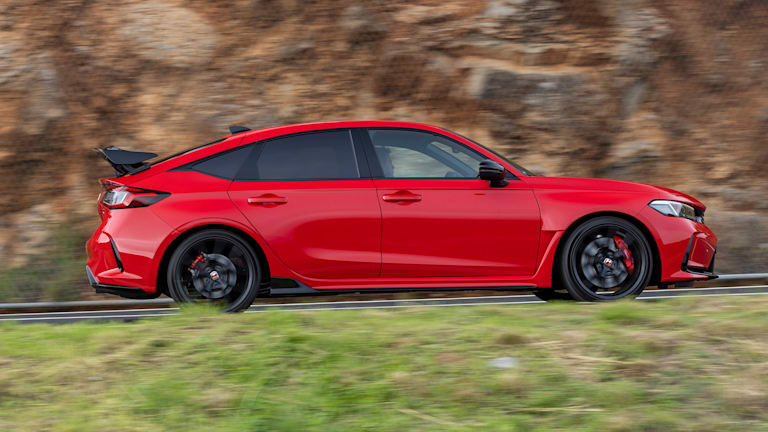
Build and powertrain
Under the skin, the FL5 features 3.8 times the structural adhesive of the FK8 to improve body rigidity, particularly at the rear of the car.
The use of adhesives has also helped save weight, obviating the need for additional steel bracing. Other weight saving measures include the new aluminium bonnet, which is 43 percent lighter than the FK8’s steel item, and a resin rear hatch that’s 20 percent lighter.
The revised version of the K20C1 four-banger under the bonnet now develops 235kW at 6500rpm, and 420Nm of torque from 2200rpm to 4000rpm, increases of 7kW and 20Nm over FK8 spec. They’re not big bumps, but they’re enough to get the Type R comfortably into the 5 second bracket for the 0-100km/h sprint – Honda claims 5.4 seconds, compared with the 6.0 seconds we recorded when testing an FK8 Type R back in mid-2020.
As any tuner knows, there’s a law of diminishing returns when it comes to tweaking an engine that’s already making big power and torque for its size. The FK8’s engine punched out 117kW per litre. Getting the FL5 version to better that number by just three percent involved fitting a redesigned turbocharger that, among other things, features fewer blades on the impeller to reduce inertia by 14 percent and thus reduce lag, as well as designing an intake and exhaust system with 10 and 13 percent better flow rates, respectively.
To help engine response, particularly in terms of rev matching on downshifts, the flywheel is 18 percent lighter overall, and where the weight has been removed has reduced the flywheel’s inertia by 25 percent.
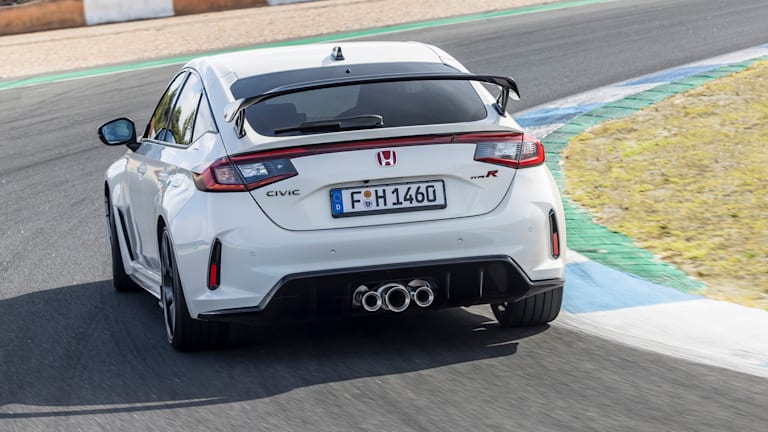
The FK8’s six-speed manual was already one of the best in the business in terms of shift feel and precision, but Honda engineers thought there was still room for improvement.
As a result, the FL5 Type R’s shifter has a more rigid throw, less free play, and moves across a carefully optimised gate that’s been designed for faster, more precise shifts between second and third, and fourth and fifth gears.
The new Type R has the fundamentally same suspension layout as the previous model, though everything has been tweaked. The adaptive dampers, carried over from the FK8, feature a revised control logic for roll and pitch control.
The dual-axis front suspension, which helps minimise torque steer, has new lower arms that deliver a 16 percent increase in camber rigidity over the previous generation Type R. The front axle geometry has also been revised to make better use of the increased engine torque and the 265/30 R19 Michelin Pilot Sport 4S tyres.
The decision to step down from 20-in to 19-in rims compared with the FK8 Type R was driven by the dimensional changes of the FL5 platform, their effect on the suspension geometry, and improvements in tyre technology.
The Michelins have been engineered to work their inner edges harder than before, and the new 19in alloy wheels thus have their smallest inner diameter on the inside of the rim, rather than the outside, as is usual. That’s why the new 19in wheels look like 20s from a distance.

Lurking behind the wheels is an upgraded Brembo braking system that features a new mechanical brake master cylinder to improve tip-in feel.
Revised brake ducts help keep the rotors and callipers cooler – Honda engineers claim they’ve seen 60 degree C lower pad temperatures than in the FK8 after five hot laps of Suzuka.
To make the most of the more responsive chassis, the steering column has bearings honed to improve rigidity and longevity, and the tie-rod ends are made from a high-rigidity material for increased steering feel.
Thanks to upgrades to the electronic power steering control software a larger diameter, a 60 percent more rigid torsion bar reduces unwanted steering deflections to improve feedback and response.
Telemetry: Geeking out
Data geeks will go all gooey over the new Type R’s upgraded Honda Log R 2.0 performance data acquisition app.
The app is now built into the car’s infotainment system and no longer requires hosting via a hardwired smartphone and features a Performance Monitor function and a Scoring function.
In Performance Monitor, 12 separate items of vehicle information can be displayed including engine, water, and oil temperatures as well as steering angle, brake pressure, accelerator pedal angle and yaw rate.
New is a digital tyre friction circle display, which calculates and shows in real time the potential maximum grip each of the four tyres, as well as the value of the grip levels achieved.
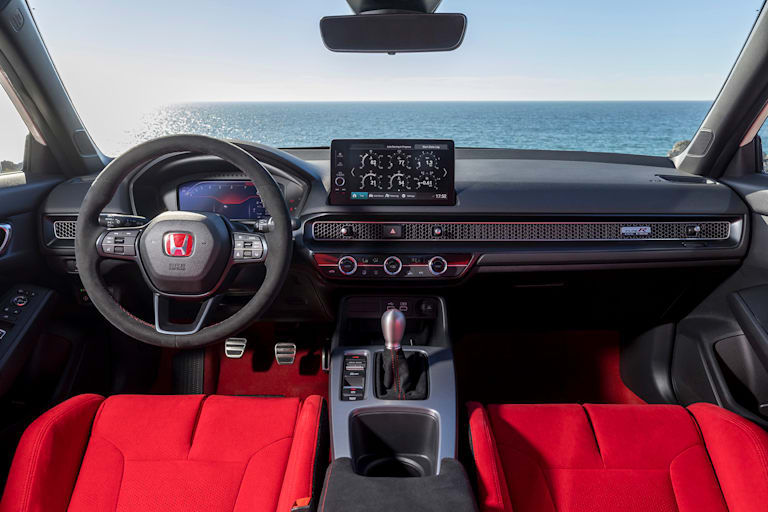
The Scoring function allows Type R drivers to review their driving to help improve skills behind the wheel. An Auto Score function evaluates driving performance on the public road in everyday situations, while the Data Log function records and analyses track driving data.
In Data Log mode the system awards up to 100 performance-based points per lap, the total determining whether the car considers you to be a C, B, A, S, or S+ driver – with S+ as the best.
It’s the same system Honda uses to rank its professional R&D evaluators. Never mind F1...
With Honda even we mere mortals now have nowhere to hide when it comes to explaining a duff lap time.
Driving and comfort
Despite all the focus on its capability on the track, most Civic Type Rs of course spend most of their lives on the road. And the good news is the FL5 version is not just a great track day weapon, but a terrific road car, too.
Inside the roomier interior, the trademark bright red R-spec front seats are supportive and comfortable, although the lever to adjust the backrest is almost impossible to operate with the seatbelt fastened. For a car that elsewhere displays such meticulous attention to detail, it’s an unforgivable error. The steering wheel is just the right diameter, and the rim is not too thick. The graphics on the digital dash are clean and bright.
Pressing the +R button on the centre console changes the dash display to a race-style layout with a bar-type tach, shift lights, and the selected gear displayed front and centre.
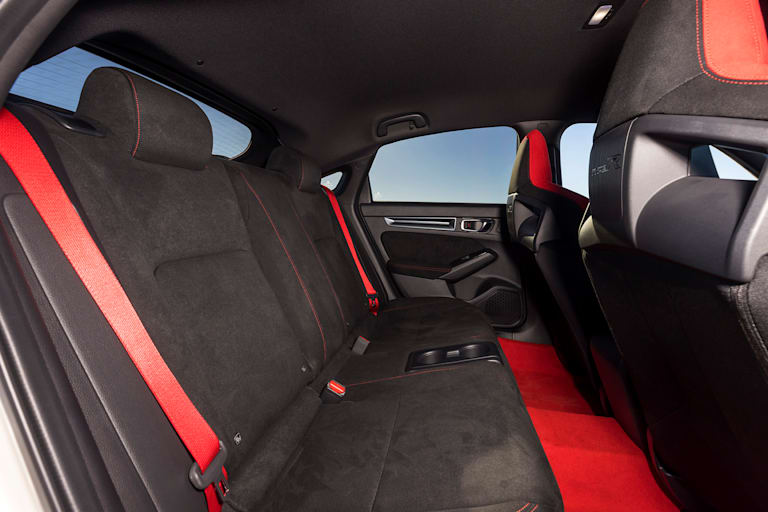
Pressing the +R button, which activates the race-face +R drive mode, is best left for the track, however, not the least because the +R mode’s adaptive damping setting is so stiff the ride will jiggle your kidneys and blur your vision on anything other than billiard table-smooth roads.
If you want to have a lash on a quiet back road, Sport mode works just fine in terms of the body control and steering weighting and throttle response. The 2.0-litre VTEC turbo’s meaty mid-range and solid top end, combined with the well-stacked gear ratios, means you’re never really wrong-footed by a deceptive corner, and the wonderful steering, prodigious front-end grip and finely wrought chassis balance means the Type R changes direction with an alacrity few front drive cars can match.
What’s more, the FL5 Type R now offers an Individual mode that allows you to mix and match various elements of the Comfort, Sport, and +R drive modes to your liking. That means you can set the engine and steering to the most responsive +R settings, for example, while having the dampers, engine noise and automatic rev match function in either Sport or even Comfort settings.
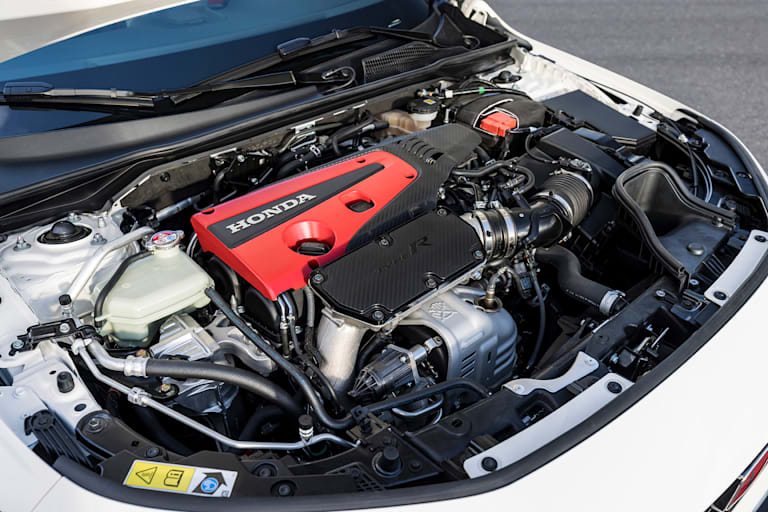
The 2.0-litre VTEC turbo’s meaty mid-range and solid top end, combined with the well-stacked gear ratios, means you’re never really wrong-footed by a deceptive corner
Even better, the Type R will remember your last selected drive mode the next time you start the car.
In baseline Comfort mode, the Type R still feels very taut and tied down, but there’s just enough syrup in the inputs to make the car a liveable daily driver. Indeed, it feels a much more grown-up car than its predecessor all round; less raw and raucous, more sophisticated.
Which is just as well, because this Type R, first deliveries of which in Australia are expected in February 2023 carries a rather grownup price tag, too – a haggle-free $72,600, drive away. That’s a hefty $20,000 more than you’ll pay for Hyundai’s rascally i30 N hatch, and about the same money you’ll hand over for a Mk 8 Golf R, Wolfsburg’s all-wheel drive stealth supercar. Is it worth it? If you want what is the best front-drive hot hatch in the business, then yes.
But there’s one thing more. Could the expensive new Type R, a better car in every respect, be just a little too suave and sophisticated for fans of the demented FK8 model, which ended its life as the best-selling Civic Type R in history? Time will tell.
Related video
2023 Honda Civic Type-R specifications
| Honda Civic Type-R | |
|---|---|
| Price | $72,600 driveaway |
| DRIVETRAIN | |
| Engine | 2.0-litre 4-cylinder turbo |
| Layout | front-engine, front-wheel drive |
| Capacity | 1996cc |
| Power | 235kW @ 6500rpm |
| Torque | 420Nm @ 2200-4000rpm |
| Transmission | 6-speed manual |
| CHASSIS | |
| Body | steel, 5 doors |
| L/W/H/W–B | 4595/1890/1405/2735mm |
| Track (f/r) | 1625/1610mm |
| Weight | 1430kg |
| Boot | 410L |
| Fuel/tank | 95 RON / 47 litres |
| Economy | 9.8L/100km (claimed combined) |
| Suspension | Front: Dual-Axis MacPherson Strut - Rear: multi-link |
| Steering | electric dual-pinion |
| Front brakes | ventilated discs (350mm) |
| Rear brakes | solid discs (305mm) |
| Wheels | 19-inch alloys |
| PERFORMANCE | |
| 0-100km/h | 5.4sec (claimed) |
Things we like
- Terrific chassis and steering
- Muscular powertrain
- A fast and useable daily driver
Not so much
- Expensive
- Poor seat adjustment
- +R suspension setting too stiff for road use


COMMENTS